Heating cable for sewer pipes: types, how to choose and correctly carry out installation
Deepening the external sewage system deeper than the freezing ground - troublesome work, especially if the work is done in winter. An alternative frost protection option is a heating cable for sewer pipes. You should familiarize yourself with the features of its styling, agree?
From the article we have proposed, you will learn all about the cable heating device for sewer pipelines. We will tell you how the heating cable works and how to correctly choose the best option. For independent owners, a step-by-step guide to laying and fixing is provided.
The content of the article:
Why is the sewage freezing?
The problem of freezing the sewer pipe is not detected immediately. Unlike water utilities, here the fluid flow is not constant and does not completely fill the pipe section.
In addition, sewage entering the sewage system usually has a higher temperature than, for example, water from a well. Therefore, the freezing of effluents occurs gradually.
At first, only some small part of the contents of the sewage system can freeze, then another layer of frozen sewage appears, etc. Gradually, the entire lumen of the pipe is filled with a dense frozen mass, after which the problem becomes apparent. The problem can be aggravated by faulty plumbing, for example, a leaking tap or tank.
Small portions of water fall into the sewer, cool quickly and freeze. Even the correct laying of sewer pipes and the presence of a layer of insulation do not always prevent the freezing of drains. Defrosting a frozen sewer is troublesome, in addition, this phenomenon can lead to damage to pipes, some of which will have to be replaced.
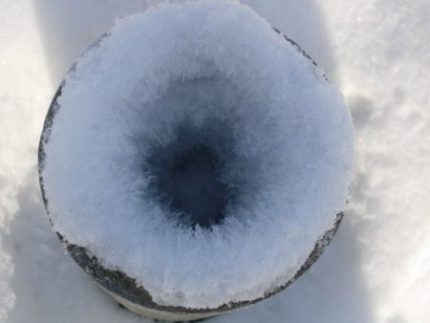
Therefore, it is recommended that the sewer be laid below the level of soil freezing with mandatory insulation of communications.To dig a rather deep trench in the southern regions and the middle lane is usually not a problem, then in the north everything is a little more complicated. In this situation, the use of a special heating or hot cable is more than appropriate.
When using this type of system, the volume of excavation is noticeably reduced, since the depth of the trench can be reduced to an acceptable level without worrying about freezing the soil.
How does the heating cable work?
A heating or hot cable is a heating system for pipes laid in the soil. The electrical cable in the insulating sheath is fixed to the pipe and connected to the power supply. The pipe heats up, as a result, the wastewater acquires a stably high temperature, which reliably protects them from freezing.
Distinguish a cable for external heating of a pipe or internal. The first is laid outside the structure, and the second inside. It is believed that outdoor installation is easier than internal, so it is more in demand. In addition to the external cable, a heating film is also used.
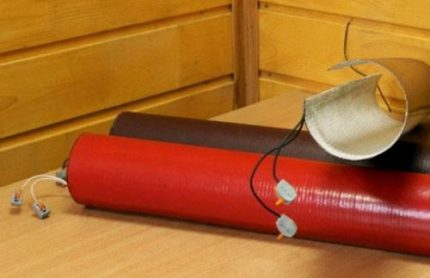
This material is completely wrapped around the structure, then it is fixed. The film gives a more uniform heating of the pipe than the cable, it has less power, which allows to slightly reduce operating costs.
To heat the pipes, you can use a cable of three types:
- self-regulating;
- resistive;
- zonal.
A self-regulating cable is considered an extremely convenient option, since it can automatically change the heating temperature depending on climatic conditions. Cable resistance decreases if the soil heats up more, and increases with decreasing temperature.
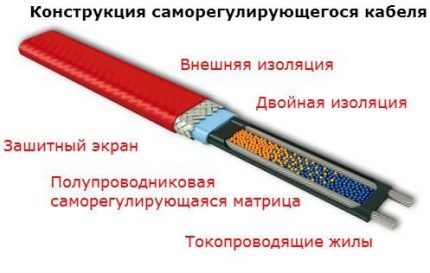
Such a change in operating mode reduces the overall power of the system, i.e. allows you to save electricity. Moreover, the change in resistance may be different in individual sections of the pipeline. The result is a higher quality of heating, itself self-regulating cable will last longer, and there is no need to install temperature controllers.
The resistive cable does not have such capabilities, but differs in comparison with self-regulating systems at a more moderate price. When installing this type of cable, you will need to install a set of temperature sensors and temperature controllers to ensure that the system changes when the weather changes.
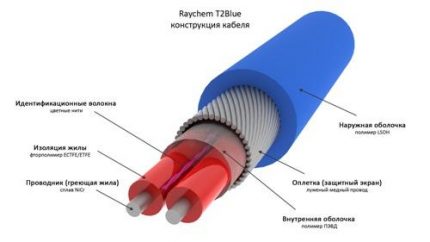
If this requirement is neglected, the risk of overheating of the cable and its breakage increases. The zone cable also does not have the ability to regulate resistance, but this system does not generate heating along its entire length, but only in separate areas. Such a cable can be cut into separate fragments, which is convenient when installing pipelines of complex configuration.
It is also widely used in the installation of metal sewers or for heating tanks. It is worth noting that heating structures buried in the ground is not the only area of use for heating cable. It is also used to heat pipes laid on the surface or in rooms that are not heated.
Sometimes the cable is used only for individual sections of the pipeline, for example, parts that come to the surface. Systems that are mounted inside the pipe are used relatively rarely. Most often they are used if the pipeline has already been laid in the ground, and the installation of an external cable would require voluminous earthwork.
So installing an internal cable will be much cheaper. But such cables are usually recommended to be used only inside pipes of small diameter, since their power is small.
It varies between 9-13 W / m, which is usually not enough for large sewer pipes. The length of such a cable, for obvious reasons, should be equal to the length of the pipe. The internal heating cable is made only of a self-regulating type.
How to choose the right cable?
When choosing the right hot cable, you need to determine not only its type, but also choose its power correctly.
In this case, it is necessary to take into account such parameters as:
- design purpose (for sewerage and water supply, calculations are performed differently);
- the material from which the sewage system is made;
- diameter of the pipeline;
- features of the site that is supposed to be heated;
- characteristic of the used insulating material.
Based on this information, heat losses are calculated for each meter of the structure, the type of cable, its power are selected, and then the appropriate length of the set is determined. Calculations can be performed using a special formula, according to calculation tables, or using an online calculator.
The calculation formula looks like this:
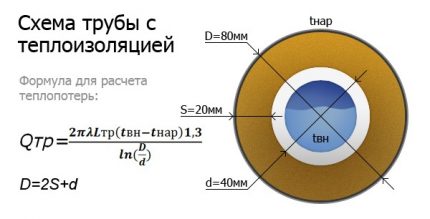
When heat losses are calculated, the length of the system should be calculated. For this, the obtained value must be divided by the specific power of the cable of the heating device. The result should be increased, given the heating of additional elements. The power of the cable for sewage starts from 17 W / m and can exceed 30 W / m.
When it comes to sewer polyethylene and PVC pipelines, then 17 W / m is the maximum power. If you use a more efficient cable, then there is a high probability of overheating and damage to the pipe. Information about the characteristics of the product can be found in its technical passport.
Using the table to choose the right option is a little easier. To do this, you first need to find out the diameter of the pipe and the thickness of the insulation, as well as the estimated difference between the temperature of the air and the contents of the pipeline. The latter indicator can be found using reference data depending on the region.
At the intersection of the corresponding row and column, you can find the value of heat loss per meter pipe. Then calculate the total cable length. For this, the specific heat loss obtained from the table must be multiplied by the length of the pipeline and by a factor of 1.3.
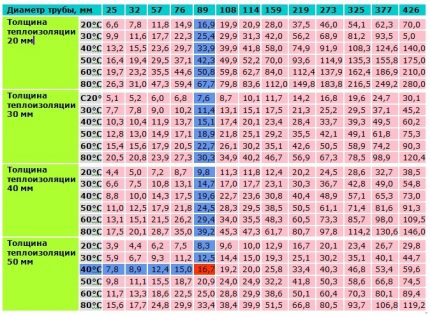
The result should be divided by the specific power of the cable. Then you need to take into account the influence of additional elements, if any. On specialized sites you can find convenient online calculators. In the appropriate fields you need to enter the necessary data, for example, pipe diameter, insulation thickness, ambient and working fluid temperature, region, etc.
Such programs usually offer the user additional options, for example, help to calculate the required diameter of the sewer, the size of the insulation layer, type of insulation, etc.
Optionally, you can choose the type of installation, find out the appropriate step when installing the heating cable with a spiral, get a list and the number of components that will be needed to install the system.
When choosing a self-regulating cable, it is important to correctly take into account the diameter of the structure on which it will be installed.For example, for pipes with a diameter of 110 mm, it is recommended to take the brand Lavita GWS30-2 or a similar version from another manufacturer. For a 50 mm pipe, Lavita GWS24-2 cable is suitable, for structures with a diameter of 32 mm - Lavita GWS16-2, etc.
Complex calculations will not be needed for sewage, which is not often used, for example, in a summer cottage or in the house used, only occasionally. In such a situation, they just take a cable with a power of 17 W / m with a length corresponding to the size of the pipe. A cable of this power can be used both outside and inside the pipe, and it is not necessary to install a gland.
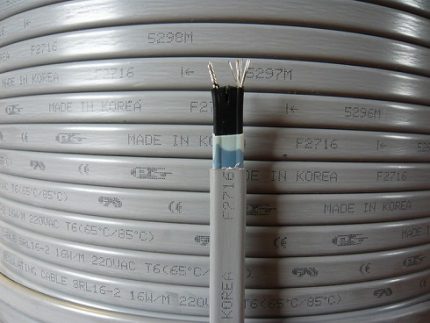
For heating cable gaskets inside the pipe choose a cable with special protection against aggressive influences, for example, DVU-13. In some cases, for installation inside use the brand Lavita RGS 30-2CR. This is not quite the right but acceptable solution.
Such a cable is designed to heat the roof or storm sewers, therefore it is not equipped with protection against corrosive substances. It can be considered only as a temporary option, because with prolonged use under inappropriate conditions, the Lavita RGS 30-2CR cable will inevitably break.
Rules for installing cable on pipes
Laying the heating cable is a relatively simple process. It is simply fixed on the surface of the pipe, usually along, in one strip. Separate projects include spiral mounting. In this case, it is necessary to accurately maintain the calculated step between the turns of the spiral so that the pipe warms up evenly.
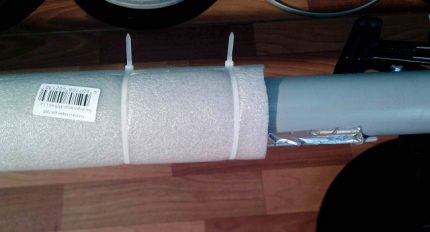
The intersection of individual sections of the heating cable is unacceptable. The cable, depending on the type, is secured with heat-resistant adhesive tape or mounting ties. The step between the attachment points must be at least 200 mm. To fix the cable in the mineral sheath, metal fasteners are used: tie straps or a special bandage.
But most often I still use heat-resistant tape. Fasteners should not only tolerate high temperatures, but also be resistant to the influence of natural factors and chemicals. Sometimes aluminum tape is used as a fastener. But in places of fastening, the thermal power of the cable will increase.
This is not always useful, it can lead to overheating of communications. It is not recommended to use metal fasteners when installing a heating cable enclosed in a polymer insulating sheath. But in some cases, aluminum tape can even improve the situation.

When laying on a polymer pipe, metallized adhesive tape is placed both under the cable and above it. This slightly increases the thermal power, and also contributes to uniform heating of the pipeline. Inside the sewer, heating cable is used extremely rarely.
Typically, this is used to heat small areas of the system that are not in the ground, for example, sewage pumpsstimulating the movement of effluents, if natural movement is difficult or impossible.
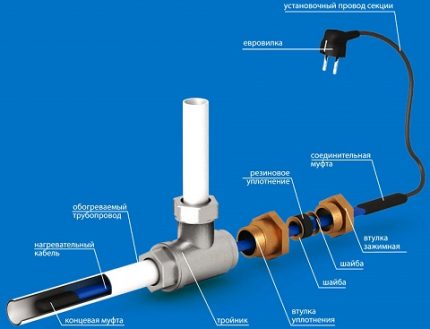
To install the internal cable into the pipe, the installation of which is completed, you will need to first insert a tee into the system. This will make a hole for introducing the cable into the pipeline.
In addition, a special nipple coupling may be required. Such a solution may slightly worsen the characteristics of the sewer system, for example, at the point of installation of the tee, the pipe clearance will slightly decrease.
This increases the likelihood of garbage accumulation and clogging. Difficulties with the internal cable are unavoidable if the pipeline has several turns, bends, etc. It is not easy to carry out internal work on installing a hot cable, as well as in sewer systems significant extent.
Of course, you should not connect the system to power until the installation is complete. Before closing the cable with insulation, carefully check all connection points. If you use temperature sensors, it will be easier to determine the time of activation and shutdown of the system.
Automate the process using a relay. If the power of the cable laid in one line is not enough, you can perform a spiral installation or lay two parallel lines. The main thing is that certain sections do not overlap, and there is no overheating. To make the heating of the structure more uniform, sometimes the pipe is first wrapped with foil, then a cable is laid on top.
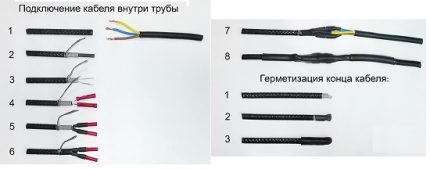
Temperature sensors are installed after the insulation is supplied. From above it is recommended to apply a marking that reflects the position of the heating elements. For heating cable connection to the mains you will need a piece of heat-shrinkable pipe. Then, about 50 mm of insulation and 10 mm of braid are removed from the edge of the cable.
The separated and stripped ends are protected by pieces of heat-shrink tubing of a suitable diameter and heated with a hairdryer. Now you need to strip about 6 mm of the wire, roll them up with a spiral and clamp in a metal tube. Similar manipulations will have to be done with the power cable.
About 80 mm must be cleaned of insulation and sheath and divided into separate wires. The resulting ends are cut to 35 mm, but one wire should be left uncut for grounding. 6 mm wires are also stripped here.
Now the ends of the cables of the heating elements and power are connected in a heat shrink tube equipped with a metal sleeve. It is heated and clamped, the contact point is wrapped with thermal tape, and then closed with another protection tube.
With the features of the choice of directly pipes for an autonomous sewage device will acquaint next article, the contents of which we advise you to read.
An example of a heated sewerage device
Consider the example of constructing a drainage system for a private household. According to the project, several branches are connected to the general sewer line. All of them are laid above the horizon of seasonal freezing of soils, therefore they are equipped with a heating cable.
In order for the operation of the heating electric system to be effective and aimed directly at maintaining the positive temperature of the sewer pipe, communications are laid in an insulated trench:
Having ascertained the tightness of the assembled sewer pipeline or eliminating the leakage, if it had a place to be, proceed to lay the heating cable.
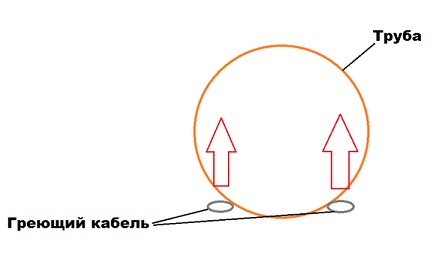
Having decided on the optimal position of the heating cable, proceed to its fastening:
In order for the system for heating communications to be able to function in automatic mode, a temperature sensor is connected to it:
Conclusions and useful video on the topic
Detailed recommendations for installing a hot cable on a pipe with a diameter of 110 mm can be found here:
This video presents an option for laying sewage using an internal cable:
Here is an overview of the features of the operation and installation of a self-regulating cable:
A hot cable solves the problem of freezing sewer pipes in winter much more effectively than other means. Electricity consumption is minimal. If the installation is done correctly, the cable will work for many years without any breakdowns.
Do you want to share the experience gained during the installation of a heating cable on your own sewer pipes in a suburban area? There is information that may be useful to site visitors interested in the question? Please write comments in the block below, ask questions and leave a photo on the topic.

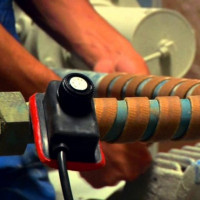 Heating cable for water supply: how to choose and correctly install it yourself
Heating cable for water supply: how to choose and correctly install it yourself  TOP 10 best remedies for clogging pipes: the best drugs on the market + how to choose
TOP 10 best remedies for clogging pipes: the best drugs on the market + how to choose  Self-regulating heating cable: overview of types and features of use
Self-regulating heating cable: overview of types and features of use 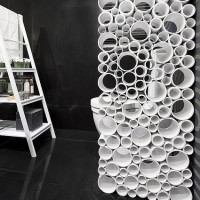 Screen made of plastic pipes: types of partitions + step-by-step manufacturing instructions
Screen made of plastic pipes: types of partitions + step-by-step manufacturing instructions 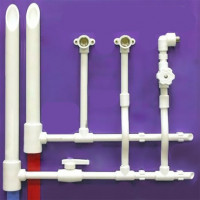 Installation of a water supply system from polypropylene pipes: typical wiring diagrams + installation features
Installation of a water supply system from polypropylene pipes: typical wiring diagrams + installation features 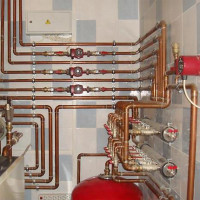 DIY copper pipe installation: copper pipe installation technology
DIY copper pipe installation: copper pipe installation technology  How much does it cost to connect gas to a private house: the price of organizing gas supply
How much does it cost to connect gas to a private house: the price of organizing gas supply  The best washing machines with dryer: model rating and customer tips
The best washing machines with dryer: model rating and customer tips  What is the color temperature of light and the nuances of choosing the temperature of the lamps to suit your needs
What is the color temperature of light and the nuances of choosing the temperature of the lamps to suit your needs  Replacement of a geyser in an apartment: replacement paperwork + basic norms and requirements
Replacement of a geyser in an apartment: replacement paperwork + basic norms and requirements
Informative, interesting material with worth reading information. Our neighbors also often had pipes freezing in winter, and they remained without water until warming began on the street. They did not know that it was possible to build a heating cable parallel to the pipeline. This is a wonderful invention. Be sure to order, purchase. A necessary thing in the economy of private houses.
In my opinion, it is best to choose a heating cable for the outer winding and with the function of self-regulation of heating. The outer winding is not only easier to install and maintain, but also minimizes the likelihood of a short circuit in the event of damage to the cable insulation and its contact with wastewater. The advantages of self-regulation of heating, I think there is no need to write - they are already understandable.